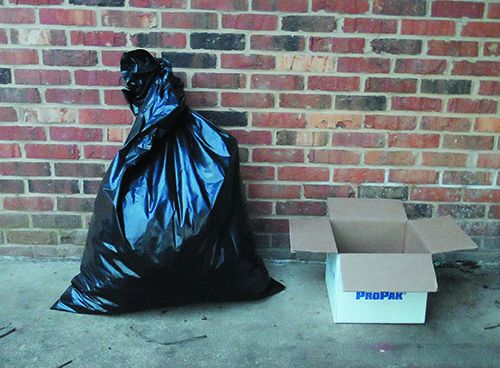It seems anomalous, but whether at home or on the boat, when we bring X volume of goods in, they expand to X+20 percent as trash. I can stash groceries in cabinets and under bunks, but garbage is smelly and bulky, not lending itself to easy storage.
Reduce the smell by washing all food contact items and combining them with recyclables. Volume can be reduced by repackaging food and reducing reliance on disposables. Washcloths replace paper towels and bottled water is replaced by a robust potable water treatment system (“Tap Water That is Better Than Bottled,” PS August 2015). Some food waste can go over the side. Alternatively, food waste can be stored in a sealable container and taken home for composting. Since we prepare meals with an eye towards minimal waste and clean our plates when cruising, there isn’t much waste.
Our solution is to take one or two sturdy boxes on board with our groceries. Although we use lightweight grocery bags to collect rubbish at various points in the cabin, we also bring a roll of heavy duty yard waste bags. Husky Heavy Duty 42-Gallon Clean-Up Bags are our preference. They are too big, but they are extremely tear resistant, and the compacting process is tough on bags. We line the box with the heavyweight bag.

Every day or two we add a grocery bag or two, lay a cardboard pusher over that, and step on it. This is repeated for as much as a week until the box is full. Crushing cans and bottles first helps. Don’t be overzealous with your stomping, or the box will burst. If the box seems fragile or you are inclined towards stomping, reinforce the box with packing tape at several levels.
Not only have you reduced the volume by 4-6 times, the boxes are less intrusive to stack and live with. Tightly sealed, they can be stacked in a corner or on the same unused bunk where they began life as stores, but now they take 50 percent of the volume.
MARPOL Rules Have Changed
Previously the discharge of paper, glass and metal were permitted outside three miles with certain restrictions. This changed in 2017, though many references have not been updated. The US is a signatory on all 7 annexes except the sewage part (Annex IV), which is instead covered by a very similar US law. Here is a portion of the restrictions, be sure to review the full text at the US Coast Guard website (https://bit.ly/39f3pDu).
- No garbage discharge within 3 miles.
- Food waste. 3-12 miles must be ground < 1-inch. Outside 12 miles grinding not required.
- Paper, metal, plastics, glass. No discharge.
- Ashes. Defined as part of garbage. No discharge.
- Plastic. No discharge.
- Oil. No Discharge.
The Drip Guard
Unless your sailing waters are among the most pristine and pollutant free, certain through hulls sprout a permanent brown or black streak. Air conditioning discharge and condensate lines are particularly prone, though any bilge line or drain can be the culprit.
The obvious solution is to get the water away from the side of the boat. The houses we install gutters. On cathedrals rainwater was discharged from the mouths of ornately carved gargoyles, casting the water outwards and preventing stains, erosion, and ice damage. The Dripperguard accomplishes the same thing in a simpler way.
Made of soft molded PVC, they are attached to through hull just under the fitting using 3M High Strength Adhesive Tape. Just clean and press. Available in black or white. Up to 1 7/8-inch is $14.95, greater than 1 7/8-inch is $16.95 (www.dripperguard.com).








































The Drip Guard: I got the drip guard for our scuppers and bilge pump discharge, and they really work. A side benefit is that I can hang a bucket over the side when it rains and collect rainwater for toilet flushing or on-deck cleaning. I always use the kind of buckets found in stables, that have a flat side on the rim. I felt this makes the bucket more efficient for bailing, but it also makes my water collection system work better by locating the flat side against the hull.
As to fans, you should check out the Karacel fan that we got from Amazon. It’s about the same size as the ones that you tested, has three speeds, is very quiet, and best of all it’s rechargeable with an included standard USB plug. The fan can be run while charging (many rechargeable devices won’t operate while in charge mode). We’ll probably buy another one. We’ve been using it for two seasons and no problems so far. https://www.amazon.com/viniper-Battery-Operated-Fan-Rechargeable/dp/B07PMGZ3Z8/ref=sr_1_13?dchild=1&gclid=Cj0KCQjwp4j6BRCRARIsAGq4yMGBWOKJFx0f1ZZdfD7Xns38MUk5o69at_5TI-cOx2vBkI0E84_CsqcaAkspEALw_wcB&hvadid=397341864617&hvdev=c&hvlocphy=9003187&hvnetw=g&hvqmt=b&hvrand=8141277796734347057&hvtargid=kwd-328177676770&hydadcr=26897_9654278&keywords=karacel&qid=1598192906&sr=8-13&tag=googhydr-20
Mark, Rigoler
1967 Morgan 34
I’ve always been told that cardboard boxes can carry cockroach eggs. When I’ve chartered in the BVI, the charter companies tell you specifically to remove any cardboard boxes you used to bring your provisions aboard. Perhaps that’s a local issue only?